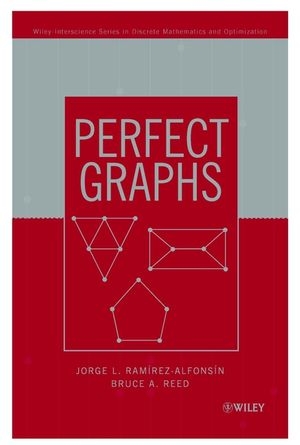
Perfect Graphs
John Wiley & Sons Inc (Verlag)
978-0-471-48970-2 (ISBN)
The theory of perfect graphs was born out of a conjecture about graph colouring made by Claude Berge in 1960. That conjecture remains unsolved, but has generated an important area of research in combinatorics. This book:
* Includes an introduction by Claude Berge, the founder of perfect graph theory
* Discusses the most recent developments in the field of perfect graph theory
* Provides a thorough historical overview of the subject
* Internationally respected authors highlight the new directions, seminal results and the links the field has with other subjects
* Discusses how semi-definite programming evolved out of perfect graph theory
The early developments of the theory are included to lay the groundwork for the later chapters. The most recent developments of perfect graph theory are discussed in detail, highlighting seminal results, new directions, and links to other areas of mathematics and their applications. These applications include frequency assignment for telecommunication systems, integer programming and optimisation.
Jorge L. Ramírez-Alfonsín is the editor of Perfect Graphs, published by Wiley. Bruce Alan Reed FRSC is a Canadian mathematician and computer scientist, the Canada Research Chair in Graph Theory and a professor of computer science at McGill University. His research is primarily in graph theory.
List of Contributors.
Preface.
Acknowledgements.
1. Origins and Genesis (C. Berge and J.L. Ramirez Alfonsin).
Perfection.
Communication Theory.
The Perfect Graph Conjecture.
Shannon's Capacity.
Translation of the Halle-Wittenberg Proceedings.
Indian Report.
References.
2. From Conjecture to Theorem (Bruce A Reed).
Gallai's Graphs.
The Perfect Graph Theorem.
Some Polyhedral Consequences.
A Stronger Theorem.
References.
3. A Translation of Gallai's Paper: "Transitiv Orientierbare Graphen" (Frederic Maffray and Myriam Preissmann).
Introduction and Results.
The Proofs of Theorems (3.12), (3.15) and 3.16).
The Proofs of (3.18) and (3.19).
The Proofs of (3.1.16).
The Proofs of (3.1.17).
Determination of all Irreducible Graphs.
Determination of the Irreducible Graphs.
References.
4. Even Pairs (Hazel Everett et al).
Introduction.
Even Pairs and Perfect Graphs.
Perfectly Contractile Graphs.
Quasi-parity Graphs.
Recent Progress.
Odd Pairs.
References.
5. The P_4-Structure of Perfect Graphs (Stefan Hougardy).
Introduction.
P_4-Stucture: Basics, Isomorphisms and Recognition.
Modules, h-Sets, Split Graphs and Unique P_4-Structure.
The Semi-Strong perfect Graph Theorem.
The Structure of the P_4-Isomorphism Classes.
Recognizing P_4-Structure.
The P_4-Structure of Minimally Imperfect Graphs.
The Partner Structure and Other Generalizations.
P_3-Structure.
References.
6. Forbidding Holes and Antiholes (Ryan Hayward and Bruce A. Reed).
Introduction.
Graphs with No Holes.
Graphs with No Discs.
Graphs with No Long Holes.
Balanced Matrices.
Bipartitie Graphs with No Hole of Length 4k + 2.
Graphs without Even Holes.
-Perfect Graphs.
Graphs without Odd Holes.
References.
7. Perfectly Orderable Graphs: A Survey (Chinh T Hoang).
Introduction.
Classical Graphs.
Minimal Nonperfectly Orderable Graphs.
Orientations.
Generalizations of Triangulated Graphs.
Generalizations of Complements of Chordal Bipartitie Graphs.
Other Classes of Perfectly Orderable Graphs.
Vertex Orderings.
Generalizations of Perfectly Orderable Graphs.
Optimizing Perfectly Ordered Graphs.
References.
8. Cutsets in Perfect and Minimal Imperfect Graphs (Irena Rusu).
Introduction.
How Did It Start?
Main Results on Minimal Imperfect Graphs.
Applications: Star Cutsets.
Applications: Clique and Multipartite Cutsets.
Applications: Stable Cutsets.
Two (Resolved) Conjectures.
The Connectivity of Minimal Imperfect Graphs.
Some (More) Problems.
References.
9. Some Aspects of Minimal Imperfect Graphs (Myriam Preissmann and Andras Sebo).
Introduction.
Imperfect and Partitionable Graphs.
Properties.
Constructions.
References.
10. Graph Imperfection and Channel Assignment (Colin McDiarmid).
Introduction.
The Imperfection Ratio.
An Alternative Definition.
Further Results and Questions.
background on Channel Assignment.
References.
11. A Gentle Introduction to Semi-definite Programming (Bruce A. Reed).
Introduction.
The Ellipsoid Method.
Solving Semi-definite Programs.
Randomized Rounding and Derandomization.
Approximating MAXCUT.
Approximating Bandwidth.
Graph Colouring.
12. The Theta Body.
References.
The Theta Body and Imperfection (F.B. Shepherd).
Background and Overview.
Optimization, Convexity and Geometry.
The Theta Body.
Partitionable Graphs.
Perfect Graph Characterizations and a Continuous Perfect Graph Conjecture.
References.
13. Perfect Graphs and Graph Entropy (Gabor Simonyi).
Introduction.
The Information-Theoretic Interpretation.
Some Basic Properties.
Structural Theorems: Relation to Perfectness.
Applications.
Generalizations.
Graph Capacities and Other Related Functionals.
References.
14 A Bibliography on Perfect Graphs (Vaek Chvátal).
Index.
| Erscheint lt. Verlag | 14.9.2001 |
|---|---|
| Reihe/Serie | Wiley-Interscience Series in Discrete Mathematics and Optimization |
| Verlagsort | New York |
| Sprache | englisch |
| Maße | 172 x 253 mm |
| Gewicht | 822 g |
| Themenwelt | Mathematik / Informatik ► Mathematik ► Graphentheorie |
| ISBN-10 | 0-471-48970-0 / 0471489700 |
| ISBN-13 | 978-0-471-48970-2 / 9780471489702 |
| Zustand | Neuware |
| Haben Sie eine Frage zum Produkt? |
aus dem Bereich
